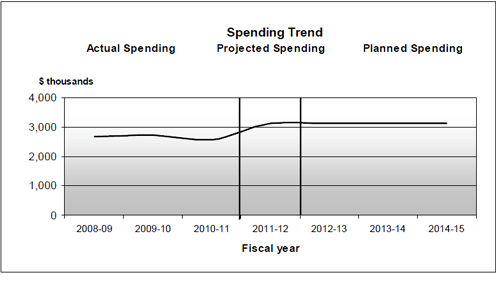ARCHIVED - Copyright Board of Canada - Report
 This page has been archived.
This page has been archived.
Archived Content
Information identified as archived on the Web is for reference, research or recordkeeping purposes. It has not been altered or updated after the date of archiving. Web pages that are archived on the Web are not subject to the Government of Canada Web Standards. As per the Communications Policy of the Government of Canada, you can request alternate formats on the "Contact Us" page.
2012-13
Report on Plans and Priorities
Copyright Board of Canada
The original version was signed by
The Honourable Christian Paradis
Minister of Industry and Minister of State (Agriculture)
Table of Contents
Section I: Organizational Overview
- Raison d'être
- Responsibilities
- Strategic Outcome(s) and Program Activity Architecture (PAA)
- Organizational Priorities
- Risk Analysis
- Planning Summary
- Expenditure Profile
- Estimates by Vote
Section II: Analysis of Program Activities by Strategic Outcome(s)
- Strategic Outcome
- Program Activity: Copyright Tariff Setting and Issuance of Licences
- Planning Highlights
- Program Activity: Internal Services
- Planning Highlights
Section III: Supplementary Information
Section IV: Other Items of Interest
Minister’s Message
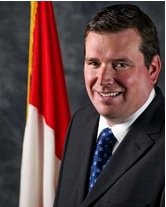 Over the past year, the Canadian economy has proven to be resilient despite continued fiscal uncertainty in other parts of the world. Since our government introduced Canada’s Economic Action Plan in 2009 to respond to the global recession, Canada has recovered not only all of
the jobs lost during the recession but also all of our economic output.
Over the past year, the Canadian economy has proven to be resilient despite continued fiscal uncertainty in other parts of the world. Since our government introduced Canada’s Economic Action Plan in 2009 to respond to the global recession, Canada has recovered not only all of
the jobs lost during the recession but also all of our economic output.
As Minister of Industry, I am confident that the Industry Portfolio will play a key role in our government’s plan to strengthen Canada’s knowledge-based economy. Our efforts will focus on promoting innovation and modernizing Canada’s marketplace policies, among other areas.
In 2012–13, Copyright Board Canada will continue to issue decisions related to tariffs of general application, licences issued where parties cannot agree or licences issued where the owner of the work cannot be found. These decisions will continue to be based on the principle of ensuring fairness while seeking to provide tangible incentives for the creation and use of copyrighted works in Canada. The Board will also examine possible avenues to improve its practices and procedures while safeguarding fairness.
A significant part of the Industry Portfolio’s activities will involve developing Canada’s digital economy by updating copyright and privacy laws and building a world-class digital infrastructure for next-generation wireless technologies and services. We will also put in place conditions that allow small businesses to grow and create jobs. This will mean reducing red tape, improving access to credit and focusing programs to promote more effective research and development.
Since coming to office, our government has made science and innovation a priority. We will leverage our past investments and continue to develop and recruit world-leading research talent. We will also take measures to encourage the private sector to increase research and development investments and improve commercialization outcomes.
In our government’s pursuit to improve the well-being of Canadians, we will continue to work to secure the recovery, eliminate the deficit and invest in the drivers of long-term economic growth. We will also implement our plan to find savings in government expenditures to return to fiscal balance in the medium term.
This year’s Report on Plans and Priorities for Copyright Board Canada delivers a comprehensive approach to promote and maintain Canada’s strong and competitive economy. I look forward to working with my Cabinet and departmental colleagues, as well as with the private sector and other levels of government, to achieve our common goal of creating jobs and growth for all Canadians.
The Honourable Christian Paradis
Minister of Industry and
Minister of State (Agriculture)
Section I: Organizational Overview
Raison d’être
The Copyright Board is an economic regulatory body empowered to establish, either mandatorily or at the request of an interested party, the royalties to be paid for the use of copyrighted works, when the administration of such copyright is entrusted to a collective-administration society. The Board also has the right to supervise agreements between users and licensing bodies and issues licences when the copyright owner cannot be located.
Responsibilities
The responsibilities of the Copyright Board under the Act are to:
- certify tariffs for
- the public performance or the communication to the public by telecommunication of musical works and sound recordings;
- the doing of any protected act mentioned in sections 3, 15, 18 and 21 of the Act; and,
- the retransmission of distant television and radio signals or the reproduction and public performance by educational institutions, of radio or television news or news commentary programs and all other programs, for educational or training purposes.
- set levies for the private copying of recorded musical works;
- set royalties payable by a user to a collective society, when there is disagreement on the royalties or on the related terms and conditions;
- rule on applications for non-exclusive licences to use published works, fixed performances, published sound recordings and fixed communication signals, when the copyright owner cannot be located;
- examine agreements made between a collective society and a user which have been filed with the Board by either party, where the Commissioner of Competition considers that the agreement is contrary to the public interest;
- receive such agreements with collective societies that are filed with it by any party to those agreements within 15 days of their conclusion; and,
- set compensation for formerly unprotected acts in countries that later join the Berne Convention, the Universal Convention or the Agreement establishing the World Trade Organization.
Finally, the Minister of Industry can direct the Board to conduct studies with respect to the exercise of its powers.
Strategic Outcome(s) and Program Activity Architecture (PAA)
| STRATEGIC OUTCOME | PROGRAM ACTIVITY | |
|---|---|---|
| Fair decision-making to provide proper incentives for the creation and use of copyrighted works | Copyright Tariff Setting and Issuance of Licences | |
| Internal Services |
Organizational Priorities
| Priority | Type | Strategic Outcome(s) and/or Program Activity(ies) |
|---|---|---|
| Ensure timely and fair processes and decisions | Ongoing | Fair decision-making to provide proper incentives for the creation and use of copyrighted works |
| Description | ||
|
Why is this a priority? The requirement to have timely decisions is expressly stated in the Act: the Board is to certify and publish tariffs “as soon as is practicable.” The requirement to have fair processes and decisions is implicit: the Act gives the Board the powers, rights and privileges of a superior court; as such, the Board is required to follow the principles of natural justice which, taken together, ensure both fair processes and fair outcomes. Plans for meeting the priority To achieve this priority, the Board will need to ensure that participation costs in the hearing process are kept as low as possible, thus encouraging participation of the parties and streamlining the process. The Board will also need to provide appropriate guidance, information and analysis to the participants in order to facilitate the examination process and to foster greater participants’ satisfaction. This will be done, in particular, through telephone advisories and case management meetings with representatives. Finally, by engaging in prehearing consultations and information gathering, and by conducting well-organized proceedings which address key issues facing copyright-related industries, the Board will be able to issue timely and fair decisions. The monitoring of this priority will be achieved by informally surveying hearing participants, with follow-up examination and determination of alternative procedural practices to improve the efficiency of the regulatory process. The achievement of this result is also directly monitored through the timely conduct of hearing processes and lack of interruption in proceedings due to administrative and technical delays. In addition, the implementation of a pre-hearing joint statement of (non-contested) facts and handling of legal issues solely through written submissions will improve the efficiency of the process. Finally, the Board plans to continue to examine, for each process, how to structure and sequence witnesses and hearing stages so as to eliminate duplication and maximize time spent on relevant issues. In addition, in 2012-13, the Board plans to establish a working group comprised of key stakeholders that will examine possible avenues to improve the Board’s rules of practice and procedure. These improvements should aim at reducing uncertainty and streamlining the procedures while safeguarding the fairness of the process. The rationale underlying this priority is to minimize administrative costs to Canadians from the setting of tariffs and to streamline the process in the face of increasing complexities in hearing subject matter, thus increasing regulatory efficiency. To the extent that this also leads to fairer decision-making, the overall innovation capability of parties affected by the copyright tariff process will be improved. |
||
| Priority | Type | Strategic Outcome(s) and/or Program Activity(ies) |
|---|---|---|
| Advance the analytical framework for decisions and the regulatory processes for tariffsetting | Ongoing | Fair decision-making to provide proper incentives for the creation and use of copyrighted works |
| Description | ||
|
Why is this a priority? The Board is required, under the Act, to give reasons for its decisions. In keeping with the modern principles of judicial review, the Federal Court of Appeal typically defers to the Board’s expert understanding of the facts before it. The Board can only maintain this deference by constantly advancing its analytical frameworks. Plans for meeting the priority Among the most significant risks which the Board faces in achieving its strategic outcomes are the potentially disruptive impact of new technologies, in particular on how copyright material is utilized, distributed and monitored. Fair and equitable decisions critically depend on the Board’s ability to identify, understand and assess the industry issues before they adversely impact existing copyright regimes. The Board’s approach to managing the technology risk is to systematically monitor relevant journals, other publications and websites, and to attend industry seminars and conferences. Knowledge of the international experience is also a key tool in addressing the challenges of changing technology and the impact of global events. By comparing experiences across different countries, the Board expects to gain early warning of significant developments and their likely impacts on the Canadian situation. Leadership in copyright matters will continue to build on the groundwork performed in the past. The Board plans to continue its leadership role in the establishment and expansion of international activities such as sharing of procedures, data, analysis and other information. With a view to further this leadership, the Board will continue to be actively involved with the international Society for Economic Research on Copyright Issues in 2012-13. By its involvement in international activities as they relate to copyright tariff setting in other parts of the world, the Board ensures that its own tariff-setting processes and decisions are cognizant of developments outside of Canada. |
||
Type is defined as follows: previously committed to – committed to in the first or second fiscal year prior to the subject year of the report; ongoing – committed to at least three fiscal years prior to the subject year of the report; and new – newly committed to in the reporting year of the RPP or DPR.
Operating Environment
The Act details the mandate of the Copyright Board of Canada. The Board has substantive and procedural powers, granted both in the Act and implicitly recognized by the courts.
The Act requires that the Board certify tariffs in the following fields: the public performance or communication of musical works and of sound recordings of musical works, the retransmission of distant television and radio signals, the reproduction of television and radio programs by educational institutions and private copying. In other fields where rights are administered collectively, the Board can be asked by a collective society to set a tariff; if not, the Board can act as an arbitrator if the collective society and a user cannot agree on the terms and conditions of a licence.
The examination process is always the same. Tariffs always come into effect on January 1. On or before the preceding 31st of March, the collective society must file a statement of proposed royalties which the Board then publishes in the Canada Gazette. Users (or, in the case of private copying, any interested person) or their representatives may object to the statement within 60 days. The collective society and the objectors present oral and written arguments. After deliberations, the Board certifies the tariff, publishes it in the Canada Gazette, and provides written reasons for its decision.
Hearings before the Board often involve expert witnesses, litigation specialists and detailed econometric, business and financial studies, surveys and evidence. The Board needs to assess the ever-changing technological environment, global events, new business models and the interests of owners and users in order and sets tariffs to contribute to the continued growth of Canada’s knowledge industries and the rest of Canada’s economy. These assessments are reflected in the Board’s decisions and its certified tariffs, since a tariff’s structure and terms and conditions need to be set in accordance with the industry’s technology, business models and economic environment.
As a rule, the Board holds hearings. No hearing will be held if proceeding in writing accommodates a small user who would otherwise incur large costs. The hearing may be dispensed with on certain preliminary or interim issues. No hearings have been held yet for a request to use a work whose owner cannot be located. Information is obtained either in writing or through telephone calls.
Overall, the Board is responsible for tariffs worth over $400 million annually. In fact, copyright tariffs support several industries which generated 7.4 per cent GDP and 1.1 million jobs in 2007.
Risk Evaluation
Among the most significant risks which the Board faces in achieving its strategic outcomes is the potentially disruptive impact of new technologies (i.e., in terms of how copyright material is utilized, distributed and monitored). The Board’s approach to managing the technology risk is to systematically monitor relevant journals, other publications and web sites, and to attend industry seminars and conferences, as described before in this report.
The decisions the Board makes are constrained in several respects. These constraints come from sources external to the Board: the law, regulations and judicial pronouncements. Others are selfimposed, in the form of guiding principles that can be found in the Board’s decisions.
Court decisions also provide a large part of the framework within which the Board operates. Most decisions focus on issues of procedure, or apply the general principles of administrative decision-making to the specific circumstances of the Board. However, the courts have also set out several substantive principles for the Board to follow or that determine the ambit of the Board’s mandate or discretion.
A smaller risk, which the Board faces in achieving its strategic outcome, is reversal risk. While decisions of the Board are not appealable, they are subject to judicial review. The ability to schedule a number of cases in a year could be impaired if a case from a previous year were reversed on judicial review. The Board’s principal strategy to mitigate this risk is issuing fair and equitable decisions.
There is always a risk of not being able to hire or retain the staff with the necessary technical expertise to achieve required results. To mitigate this risk, the Board runs well-organized job competitions, designed to target a significant share of the pool of potential candidates. The Board also takes measures to encourage a large number of applications. The Board also works at creating a stimulating working environment conducive to a high retention rate among its employees.
Planning Summary
| 2012-2013 | 2013-2014 | 2014-2015 |
|---|---|---|
| 3,118 | 3,118 | 3,118 |
| 2012-2013 | 2013-2014 | 2014-2015 |
|---|---|---|
| 16 | 16 | 16 |
| Performance Indicators | Targets |
|---|---|
| Time to render decisions | One year, for at least 70% of the cases |
| Time to deliver licences | 45 days, for at least 70% of the cases |
| Program Activity | Forecast Spending 2011-12 |
Planned Spending | Alignment to Government of Canada Outcomes | ||
|---|---|---|---|---|---|
| 2012-13 | 2013-14 | 2014-15 | |||
| Copyright Tariff Setting and Issuance of Licences | 2,531 | 2,526 | 2,526 | 2,526 | An innovative and knowledge-based economy |
| Total Planned Spending | 2,526 | 2,526 | 2,526 | ||
| Program Activity | Forecast Spending 2011-12 |
Planned Spending | ||
|---|---|---|---|---|
| 2012-13 | 2013-14 | 2014-15 | ||
| Internal Services | 594 | 592 | 592 | 592 |
| Total Planned Spending | 592 | 592 | 592 | |
Copyright Board of Canada Spending Trend
For information on our organizational appropriations, please see the
2012-13 Main Estimates publication.
Section II: Analysis of Program Activities by Strategic Outcome(s)
Strategic Outcome
The Board’s strategic outcome is fair decision-making to provide proper incentives for the creation and uses of copyrighted works.
Program Activity: Copyright Tariff Setting and Issuance of Licences
| 2012-2013 | 2013-2014 | 2014-2015 |
|---|---|---|
| 2,526 | 2,526 | 2,526 |
| 2012-2013 | 2013-2014 | 2014-2015 |
|---|---|---|
| 14 | 14 | 14 |
| Program Activity Expected Results |
Performance Indicators | Targets |
|---|---|---|
| Fair and Equitable Tariffs and Conditions |
|
70% of tariff decisions will be published within one year 70% of licences will be issued within 45 days 70% satisfaction rate |
To ensure fair decision-making, the Board will periodically measure stakeholders’ satisfaction. A formal survey will be conducted either electronically or by telephone. The survey will assess the degree of satisfaction of its stakeholders with regard to the services it provides as part of a process leading to the issuance of a licence when the copyright owner cannot be located.
In addition, the Board will hold consultations meetings with its stakeholders to assess satisfaction as part of the process leading to the certification of a tariff.
With respect to the survey of the stakeholders’ satisfaction with the Board’s services, the Board believes that an initial satisfaction rate target of 70 per cent is reasonable, considering that it will be the first time such a survey is administered.
Improving the efficiency of the regulatory process involves continual refinements in scheduling of witnesses, establishing and communicating the parameters of the hearing to participants, consulting with key stakeholders and developing codes of hearing practice and related guidelines for the conduct of hearings. By improving the efficiency of the tariff hearing process, this activity is expected to contribute to the objective of reducing the regulatory burden.
With respect to the number of months before a tariff decision is issued, the Board believes that a target of 12 months should be set for the next fiscal year, with a complying percentage of 70 per cent. Considering that the Board’s resources have recently increased, it would be unrealistic to set a shorter target. However, in the next few years, as new personnel are added, the Board will re-examine the possibility of reducing the 12-month target.
In addition, pursuant to section 77 of the Act, the Board may grant licences that authorize the use of published works, fixed performances, published sound recordings and fixed communication signals if the copyright owner cannot be located. Since 1989, the Board has issued 214 such licences. The Board’s objective with respect to this activity is to issue licences in a timely manner. Therefore, we will also gather data on the number of months between the date when a particular licence file is closed, and the date of issuance of the licence.
De plus, l’article 77 de la Loi prévoit que la Commission peut délivrer une licence autorisant l’accomplissement de tout acte à l’égard d’une oeuvre publiée ou d’une fixation d’une prestation, d’un enregistrement sonore publié ou d’une fixation d’un signal de communication lorsque le titulaire du droit d’auteur est introuvable. Depuis 1989, la Commission a délivré 214 licences de ce genre. L’objectif de la Commission par rapport à cette activité est de délivrer des licences en temps opportun. Nous colligerons donc des informations à l’égard du nombre de mois entre la date de complétion d’un dossier de licence particulier et la date de délivrance de la licence.
With respect to the number of months before a licence is issued, the Board believes that a delay of 45 days between the file completion date and the issuance of the licence is appropriate, and that this delay should be met in at least 70 per cent of the files. Again, as new resources are added to this area, the Board will reexamine the possibility of reducing the 45-day target.
Program Activity: Internal Services
| Financial Resources ($ thousands) | ||
|---|---|---|
| 2012-2013 | 2013-2014 | 2014-2015 |
| 592 | 592 | 592 |
| Human Resources (Full-Time Equivalent – FTE) | ||
|---|---|---|
| 2012-2013 | 2013-2014 | 2014-2015 |
| 2 | 2 | 2 |
Planning Highlights
This activity deals with financial and materiel management policies, systems, processes and standards. In implementing these policies, compliance with Parliament's requirements for financial stewardship and probity must be ensured. This activity also encompasses the responsibility of providing human resource services.
The Board receives timely support from internal services, namely: finance; human resources; communications; information management and information technology. This activity contributes to the creation of an environment that will allow the Board to fulfill its mandate and realize its objective.
In 2012-13, Internal Services will establish a human resources plan that provides for the staffing of some positions, notably a legal counsel, an economist, and a director of research and analysis. Some work on these hiring processes was done during 2011-12, but the work will continue into 2012-13.
Section III: Supplementary Information
The future-oriented financial highlights presented within this RPP are intended to serve as a general overview of the Board’s financial position and operations. These future-oriented financial highlights are prepared on an accrual basis to strengthen accountability and improve transparency and financial management.
Future-Oriented Financial Statements
Future-oriented financial statements can be found on the Board’s website at:
http://www.cb-cda.gc.ca.
| % Change | Estimated Results 2011-12 |
Planned Results 2012-13 |
|
|---|---|---|---|
| Assets | |||
| Due from the Consolidated Revenue Fund | 15% | 62 | 71 |
| Accounts Receivable and Advances | -38% | 24 | 15 |
| Tangible Corporate Assets | -35% | 31 | 20 |
| TOTAL | -9% | 117 | 106 |
| Liabilities | |||
| Accounts Payable and Accrued Liabilities | 0% | 86 | 86 |
| Other Liabilities | 0% | 362 | 362 |
| Total Liabilities | 0% | 448 | 448 |
| Equity | 3% | (331) | (342) |
| TOTAL | -9% | 117 | 106 |
| % Change | Estimated Results 2011-12 |
Planned Results 2012-13 |
|
|---|---|---|---|
| Expenses | |||
| Salaries and Benefits | 0% | 2,142 | 2,135 |
| Other Expenses | 0% | 1,332 | 1,332 |
| NET COST OF OPERATIONS | 0% | 3,474 | 3,467 |
Assets by Type
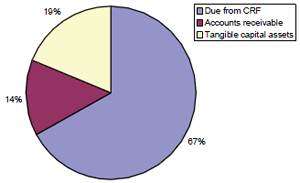 It is projected that total assets will be valued at $106,000 in fiscal year 2012-13. This is composed of amount due from the Consolidated Revenue Fund (67% or $71,000, tangible capital assets (19% or $20,000) and accounts receivable (14% or $15,000).
It is projected that total assets will be valued at $106,000 in fiscal year 2012-13. This is composed of amount due from the Consolidated Revenue Fund (67% or $71,000, tangible capital assets (19% or $20,000) and accounts receivable (14% or $15,000).
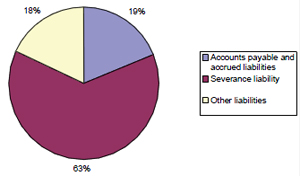 It is projected that total liabilities will be $448,000 for fiscal year 2012-13. This is mostly made up of severance benefits (63% or $280,000), accounts payable and accrued liabilities (19% or $86,000) and other liabilities (18% or $82,000).
It is projected that total liabilities will be $448,000 for fiscal year 2012-13. This is mostly made up of severance benefits (63% or $280,000), accounts payable and accrued liabilities (19% or $86,000) and other liabilities (18% or $82,000).
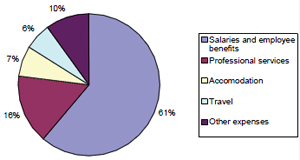 For fiscal year 2012-13, it is projected that total expenses will be $3.5 million. Most of these expenses are made up of salaries and employee benefits (61% or $2.1 million), professional services (16% or $577,000), accomodation (7% or $226,000), travel (6% or $197,000), and other expenses (10%
or $332,000).
For fiscal year 2012-13, it is projected that total expenses will be $3.5 million. Most of these expenses are made up of salaries and employee benefits (61% or $2.1 million), professional services (16% or $577,000), accomodation (7% or $226,000), travel (6% or $197,000), and other expenses (10%
or $332,000).
Section IV: Other Items of Interest
Organizational Contact Information
Copyright Board of Canada
Suite 800 - 56 Sparks Street
Ottawa, Ontario K1A 0C9
Telephone : 613.952.8621
E-mail : secretariat@cb-cda.gc.ca
Additional Information
Additional information on the Copyright Board is available in its most recent annual report, available at:
http://www.cb-cda.gc.ca/about-apropos/annual-annuel/2010-2011-e.pdf
